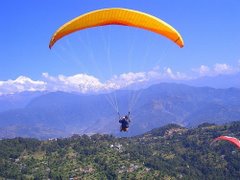Things were different in 1940-70, when there was global cooling. Every cold winter then was hailed as proof of a coming new Ice Age. But the moment cooling was replaced by warming, a new disaster in the opposite direction was proclaimed.
A recent Washington Post article gave this scientist's quote from 1972. "We simply cannot afford to gamble. We cannot risk inaction. The scientists who disagree are acting irresponsibly. The indications that our climate can soon change for the worse are too strong to be reasonably ignored." The warning was not about global warming (which was not happening): it was about global cooling!
In the media, disaster is news, and its absence is not. This principle has been exploited so skillfully by ecological scare-mongers that it is now regarded as politically incorrect, even unscientific, to denounce global warming hysteria as unproven speculation.
Meteorologists are a standing joke for getting predictions wrong even a few days ahead. The same jokers are being taken seriously when they use computer models to predict the weather 100 years hence.
The models have not been tested for reliability over 100 years, or even 20 years. Different models yield variations in warming of 400%, which means they are statistically meaningless.
Wassily Leontief, Nobel prize winner for modeling, said this about the limits of models. "We move from more or less plausible but really arbitrary assumptions, to elegantly demonstrated but irrelevant conclusions." Exactly. Assume continued warming as in the last three decades, and you get a warming disaster. Assume more episodes of global cooling, and you get a cooling disaster.
In his latest best seller State of Fear, Michael Crichton does a devastating expose of the way ecological groups have tweaked data and facts to create mass hysteria. He points out that we know astonishingly little about the environment. All sides make exaggerated claims.
We know that atmospheric carbon is increasing. We are also in the midst of a natural warming trend that started in 1850 at the end of what is called the Little Ice Age. It is scientifically impossible to prove whether the subsequent warming is natural or man-made.
Greens say, rightly, that the best scientific assessment today is that global warming is occurring. Yet never in history have scientists accurately predicted what will happen 100 years later. A century ago no scientists predicted the internet, microwave ovens, TV, nuclear explosions or antibiotics. It is impossible, even stupid, to predict the distant future.
That scientific truth is rarely mentioned. Why? Because the global warming movement has now become a multi-billion dollar enterprise with thousands of jobs and millions in funding for NGOs and think-tanks, top jobs and prizes for scientists, and huge media coverage for predictions of disaster.
The vested interests in the global warming theory are now as strong, rich and politically influential as the biggest multinationals. It is no co-incidence, says Crichton, that so many scientists sceptical of global warming are retired professors: they have no need to chase research grants and chairs.
I have long been an agnostic on global warming: the evidence is ambiguous. But I almost became a convert when Greenpeace publicised photos showing the disastrously rapid retreat of the Upsala Glacier in Argentina. How disastrous, I thought, if this was the coming fate of all glaciers.
Then last Christmas, I went on vacation to Lake Argentina. The Upsala glacier and six other glaciers descend from the South Andean icefield into the lake. I was astounded to discover that while the Upsala glacier had retreated rapidly, the other glaciers showed little movement, and one had advanced across the lake into the Magellan peninsula. If in the same area some glaciers advance and others retreat, the cause is clearly not global warming but local micro-conditions.
Yet the Greenpeace photos gave the impression that glaciers in general were in rapid retreat. It was a con job, a dishonest effort to mislead. From the same icefield, another major glacier spilling into Chile has grown 60% in volume.
Greenpeace and other ecological groups have well-intentioned people with high ideals. But as crusaders they want to win by any means, honest or not. I do not like being taken for a ride, by idealists or anyone else.
We need impartial research, funded neither by MNCs, governmental groups or NGOs with private agendas. And the media needs to stop highlighting disaster scares and ignoring exposes of the scares.


